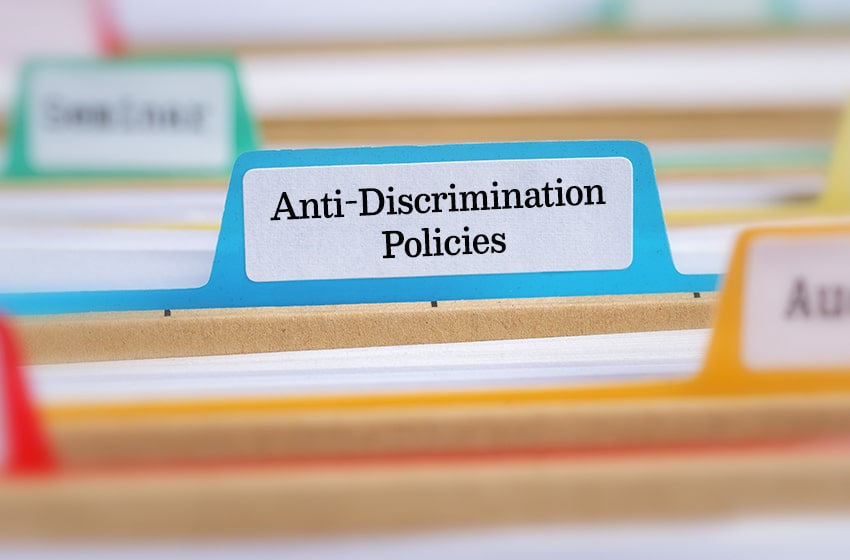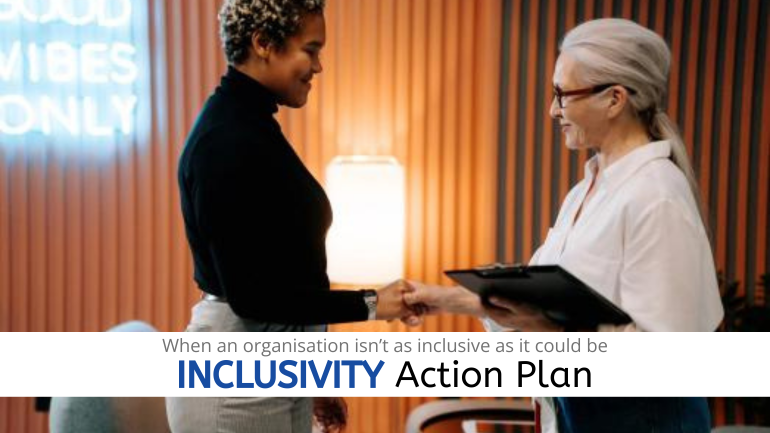What’s changing is an understanding of the importance of inclusive organisations that make all feel welcome and valued for who they are, not just what they do. Businesses are also realising that inclusive workforces are stronger and more productive workforces.
Our purpose here is not to tell you you’re doing everything wrong! In fact, because you’re reading this article we know you’re doing a lot of things right! However great one’s intentions are, though, there’s not always a clear understanding of how to get to the intended goal. So, we want to help by gathering our experts’ top ways to increase workplace inclusivity in the hope that it sparks ideas for how you can increase inclusivity within your own workplace.
Set Inclusivity and Diversity Goals

Involve Others

Involving others when establishing goals and then working to achieve them doesn’t just show that you care, it also shows that you value their input and that they belong. And, of course, it produces better outcomes. In short, it helps build inclusiveness.
Practice Diverse and Inclusive Leadership.

Diversity in leadership is important, too. People who’ve traditionally been underrepresented like seeing others like themselves in leadership. It not only fosters greater inclusiveness but also gives them reason to believe that similar opportunities exist for them. This is about finding top talent among diverse groups, and it’s out there. You might just have to look a little harder to find it.
Use Inclusive Language

Using inclusive language is vital for a healthy, inclusive workplace. Language is behaviour — we say it and then we see it.
We’re not going to kid you; this is a tricky subject that’s full of controversy and constantly changing. There’s a lot of language that’s obviously offensive, a lot that sort of seems offensive, and a lot that falls into grey areas. Plus, people with good intentions often don’t even know that language they use might be harmful to others.
This is a perfect example of how people can use offensive language without knowing.
We could write pages and pages on this topic, but there are other ideas we think you’ll find valuable. So instead, we recommend you take a look at the Australian Government Style Manual on Inclusive Language for further guidance on how to navigate this complex topic. And whatever else you do, remember our words and conversations matter. Always ask yourself, are your words going to help you connect and move closer to your work colleagues? Or are they going to result in you moving further away from those colleagues?
Before we move on to our next point, we do want to suggest one more thing related to inclusive language — always refer to other people using the language they prefer. For example, if you’re not sure what someone’s personal pronouns are, ask! You might even consider listing personal pronouns in your organisational contact directory to help with this.
Create Anti-Discrimination Policies

Promote Mentorship

Have Some Fun!

Host social events to celebrate individual and company achievements. Go out and do some team- and trust-building activities. Schedule weekly morning teas that offer a chance to relax and chat. Organise footy colour days where everyone dresses in the colours of their footy team. You could even host connection-building ‘huddles’ that don’t have a work-related agenda. For example, you might have a holiday huddle where teams share their ideas and plans for upcoming holidays. If people in your team are keen on food and cooking, you might host weekly or monthly recipe huddles where everyone shares new recipes they’ve discovered and loved. One of our team members previously worked in an area full of keen quiz-takers and every afternoon they’d have 20-50 people meet up in the tea room to do the daily newspaper quiz and see how many points they could all get.
It doesn’t matter what activities you choose as long as they appeal to the people you’re aiming to get involved.
While it’s important to maintain professional boundaries, especially between supervisors and those they supervise, socialising is a way for workers to get to know and appreciate one another as unique individuals. And that’s the foundations of building prosocial behaviours (more on that soon).
Measure Progress and Practice Accountability

Also, practice accountability.
Some people think of accountability as being related to punishment. That’s not what we’re about here at ACT Curious. All actions have consequences — whether they’re positive, negative, intended or unintended — but that’s quite different from punishment.
Accountability means holding yourself, management, and everyone else responsible for attaining the high standards you’ve set. If you don’t achieve your goals, being accountable means looking critically at what you do and what you don’t do and how those actions lead to not achieving your goals. And if you do achieve your goals, being accountable means celebrating those who contribute to that outcome.
No matter what, accountability also means striving to improve. Most people want to do the right thing and get better at what they do, so help them do that by modeling the right behaviours and providing an environment that promotes continuous improvement and accountability.
We’re all social creatures and much of our learning is social. That means we model our behaviour on that which we see exhibited by those we look up to. When you practice accountability, your workers will be more accountable too. And when you respond to and act on your individual and group shared values, your workers will be encouraged to do the same. When you model moving forward toward your individual and shared goals, even in the face of difficult thoughts and feelings from past conversations and experiences, your workers will be more likely to have courage to work past their difficult thoughts and feelings too.
Above all, you must create a safe, consistent and predictable work environment where your workers feel comfortable enough to practice the accountability you model for them. They need to feel it’s ok to fail and make mistakes, and courageous conversations need to be the norm at work. Without that, your teams will never feel comfortable innovating to achieve the kind of progress you’re aiming for and they won’t feel comfortable enough to be accountable for the mistakes they make.
Foster Prosocial Behaviour
Prosocial behaviours are a range of voluntary positive actions that are intended to help others. They can include:
- Altruism (sharing, helping etc.)
- Positive interactions (being kind, practicing positive conflict resolution, having cooperative conversations etc.)
- Cooperating (contributing to a group, doing one’s part, working towards shared goals etc.)
When you shift your workers’ focus away from themselves and onto the teams they work within and what matters most to them about being part of a group, they develop an unparalleled understanding and appreciation of their colleagues and become far more inclusive. We explore this topic in greater detail in our upcoming article on promoting prosocial behaviour to improve inclusivity — so keep an eye out for it!
AUTHOR Michelle Trudgen, Clinical Director, ACT Curious.
CONTACT US 📞 0438 922 979 (Australia Wide) email: hello@actcurious.com
DISCLAIMER The content of this blog is not intended to be a substitute for professional medical advice, diagnosis, or treatment.
COPYRIGHT © ACT Curious Pty Ltd, 2022.






